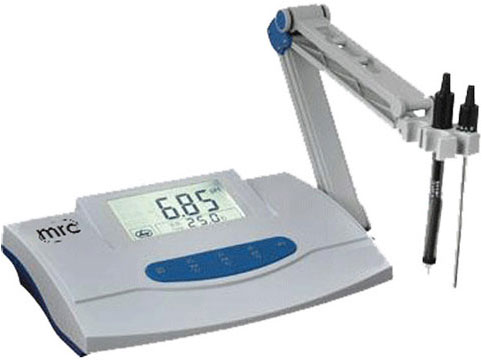MRCs provide a wide range of Ph meters for laboratories and industry.
A pH meter is an instrument used to measure the acidity or alkalinity of a solution.
Properties of pH meter
The measurement range of the PH meter we measure always ranges from 0-14.It is important to know that the lower the number - the higher the acidity level. Below 7 these are acidic values while above the 7 basic values. Measuring the acidity of a digital PH meter is a quick and accurate way to measure. It is convenient and simple to read the digital display result.
How to measure the PH:
Indicator - litmus paper changes its color according to the pH level of the solution. Each indicator has a sensitivity to a limited pH range, where it changes color.
2. Electronic pH meter-PH is based on the effect of acidity on the electrical properties of the solution. Electronic pH meters are considered to be very accurate.
Before each measurement, calibrate the device with three calibration fluids of 4, 7 and 10.
- The electronic PH uniform can come as a small device in your pocket.
Or as a portable device where the electrode is connected to a 1-meter-long electrical cable monitor.
Or as a desktop laboratory device in which the electrode is connected to a device in a 1-meter cable.
The electrodes differ from each other in their shell - glass, plastic, thin, puncture, flat.
They should be rinsed after each test and stored in a preservative. Electrode life of about one to two years (even if not used)
Glass electrode - designed for work is easy to clean but fragile and sensitive to mechanical shocks, there is a thin electrode with a diameter of 5 mm that is designed for measurements of small amounts of liquid (1 ml).

PH is a measure of the acidity level of solutions. PH affects many areas, such as cell function in the body, catalyzing chemical reactions and more.
The most common range in this acidity index is between 0 and 14.
Distilled water has its neutral value 7.
PH is a log- of the concentration of H + ions in a given solution, therefore the pH of water is 7 (-log 10-7) -.
Acidic solution: If the density of H + is higher than OH-, the substance is acidic; That is, the pH amount is less than 7. The lower the value the stronger the acid is defined.
Basic solution: If the strength of OH is higher than H +, the substance is basic, ie a pH value higher than 7. And the higher the value, the stronger the base is considered.
Neutral solution: If identical amounts of H + and OH- ions are present, the substance is neutral, with a pH of 7.
Refined water is in equilibrium with their decomposition products - hydroxide (-OH) and hydronium H) +).
PH meter calibration
Calibration is done by using calibration solutions (in bulls).
PH calibration should always start with a Calibration 7.0 solution as this is the "zero point".
Dual pH calibration using a calibration fluid of 4.0 or 10.0 (in addition to the initial 7) provides greater accuracy of the system.
Measuring range
The range we measure always ranges from 0-14.
The lower the number, the higher the acidity level
Alternatively,
The higher the number the higher the level of basicity
What is pH
in short. pH is a measure of how much acidic, neutral, or basic solution is given.
The index, which is usually on a scale of 0-14.
Neutrality - when the result is in the 7th zone.
Acidity - when the result is less than 7.
Basicness - when the result is higher than 7.
PH Meter Performance - Benefits
-Measurement accuracy-Once the meter is calibrated. The measurement results will be very accurate.
-Friendly operation. Using PH meter you can insert the probe into the liquid you are measuring
-Very high level of accuracy
Uses of PH Meters
-Inspection of detergents
-chemical and pharmaceutical industries
-Food industry
-Water quality
-Agriculture industries